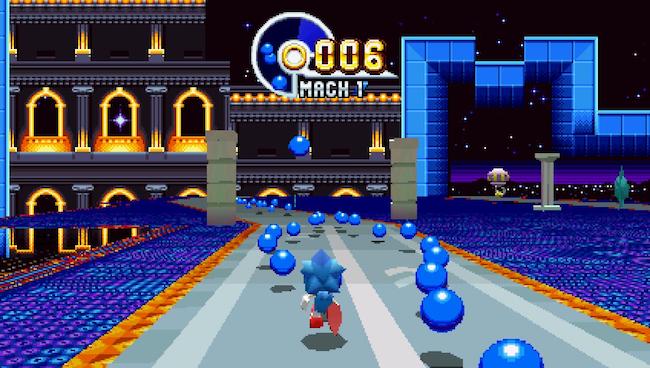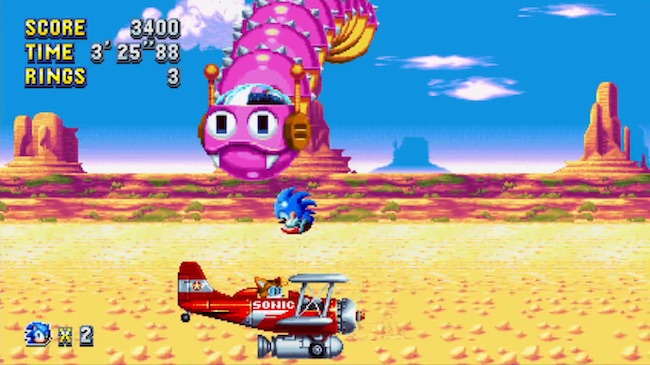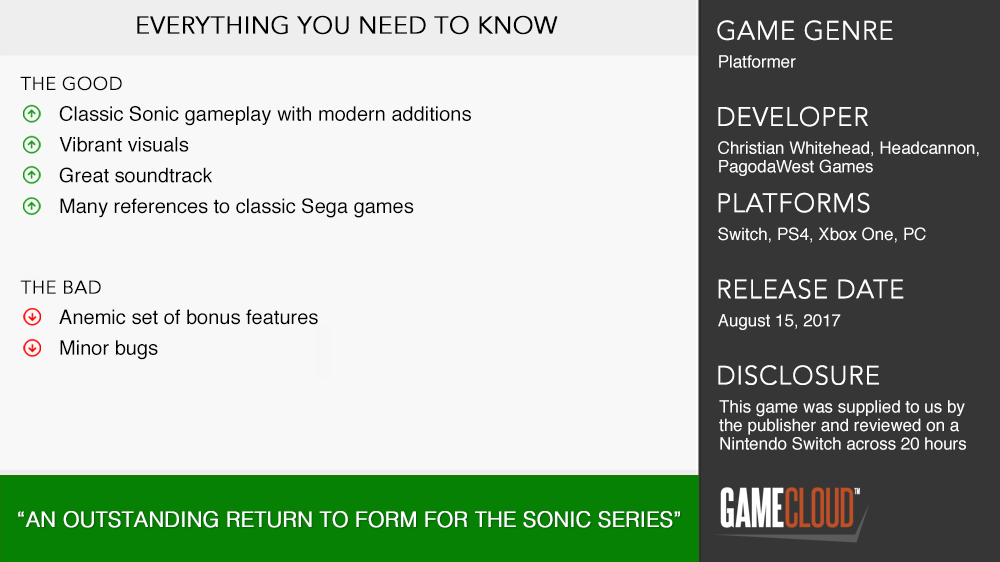
Sonic Mania was announced at Sonic’s 25th anniversary celebrations in 2016 as a traditional 2D side-scroller, developed by Christian Whitehead in conjunction with PagodaWest Games and Headcannon. Christian is well-known to members of Sonic’s fan community as the mastermind behind, among others, the excellent iOS port of Sonic CD. Fans were understandably ecstatic when Sonic Mania was announced. It finally felt like Sega had listened to its fans and built another “pure” Sonic adventure. Expectations were high, but did Christian and team deliver?
Sonic Mania follows the events of Sonic 3. Eggman and a team of his robots, the Hard-Boiled Heavies, are on the trail of a mysterious gemstone which has the ability to send Sonic, Tails and Knuckles back in time. Sonic and friends then spend the game tracking down Eggman, collecting the 7 Chaos Emeralds, and, of course, visiting zones past and present. Players will experience many obscure references to old Sonic games (as well as other Sega franchises). I don’t want to spoil any of the surprises but these will definitely bring a smile to your face.

I really enjoyed the fact that the game wastes no time on pointless exposition. Sonic Mania features no voice acting and very little by way of cutscenes – it gets you right into the action. That’s right, just like the traditional games. Some of the transitions between zones feature animations which explain the segue. However, these can be inconsistent, especially toward the latter half of the game. It’s a minor criticism but is definitely noticeable.
If you’ve played any of the Mega Drive-era Sonic games, you’ll be right at home with Sonic Mania, which is classic Sonic through and through. It plays virtually identical to those games, from the momentum you build up while going through the apex of a loop through to the speed generated from a spin dash. Everything feels great and light years ahead of the awkward physics from Sonic the Hedgehog 4 (let’s just forget those games are part of the Sonic canon). It is a real testament to the programming prowess of the development team that they have managed to nail what makes Sonic games so great – that feeling of controlled chaos paired with delicate platforming. At the best of times, Sonic Mania feels like a rhythm game.
The reverence, respect and love that Christian and team have poured into Sonic Mania is immediately evident from their updates to classic zones such as Green Hill Zone and Flying Battery Zone. Zones are split into two acts. Act 1 usually represents a relatively faithful recreation of the original zone (albeit with some surprises). Act 2, however, showcases the development team’s interpretation of those zones, which are usually more complex and intricate.

One thing has to be said about Sonic Mania’s level design, though, which is some of the strongest the series has seen. It’s exhilarating to run, loop and backtrack through a level at speed. However, it’s equally rewarding to slow things down and explore all the secrets that the developers have hidden in them. And there are a lot of them!
People have often complained about the sudden stops and attacks which cause you to lose all your rings – whether that is from an attack off screen or something that pops up right in front of you. These attacks have appeared in older Sonic games and are still here. To some extent dealing with these may involve a degree of learning and understanding the cadence of a stage. Seasoned Sonic fans won’t find these annoying, but I’d imagine that some newcomers might find such traps frustrating.
Each stage features many branching paths and secrets to discover. Stages also feature two types of “special stages.” Special Stages feature Sonic and friends running through a 3D stage collecting rings and building up speed to catch a UFO and, ultimately, earn a Chaos Emerald. These stages are a riff on similar stages from Sonic CD, although the character models appear to be adapted from those in Sonic R, a Sonic racing game on the Sega Saturn. Bonus Stages involve Sonic and friends collecting blue spheres. Completion of these stages enables you to unlock some bonus features (which I won’t spoil).

Sonic Mania is a gorgeous looking and sounding game. It’s definitely a “retro” style game, but it’s retro in a very specific way. Christian has described this game as a sequel to Sonic 3 had Sega developed it on the Sega Saturn. Included in the options are some excellent CRT filters which lend that nostalgic touch to the game. They look great on the Switch’s 6” screen or blown up on a larger TV. Furthermore, animations have been updated to take advantage of the processing power of modern consoles and there is a gorgeous colour palette which makes the game pop. Smooth scrolling raster graphics evoke a bygone era of side-scrolling excellence. There are also tons of new sprite animations for the characters alongside many which appear to have been taken from original assets.
Tee Lopes’ excellent soundtrack and remixes play a huge role in Sonic Mania’s excellent presentation, too. It’s a great mix between the sounds of old school Sonic and Hideki Naganuma’s work in Jet Set Radio and Sonic Rush, both of which were incredibly earwormy. There are some true standouts – my personal favourites are the songs for Act 2 of Green Hill Zone and Act 1 of Studiopolis.
Despite all its high points, Sonic Mania does have some missteps. The bonus features in the game are rather anaemic – upon completing the game, players unlock a versus and time attack modes and some additional capabilities for Sonic in the single player mode. But that’s about it. I would have really loved to see concept art galleries and some behind the scenes features for what has been a precedent-setting game. It’s also somewhat annoying that some of those additional features can only be experienced in a “no saves” mode. That’s right – you can’t save during the game, so anytime you lose all your lives, you’re starting from the beginning. Not cool Sega. Lastly, I also encountered some minor bugs during my playthrough. However, Christian has come out saying that the team is aware of those bugs and are working hard to crush them.

Sonic Mania is a beloved love letter to fans of the Blue Blur, and marks a sharp return to form for Sega’s beloved franchise. It is a classic platformer with modern sensibilities. It is also a great example of what happens when a major publisher hands the keys to one of its major franchises to the fans. You don’t have to be a Sonic fan to be able to enjoy this outstanding game.











